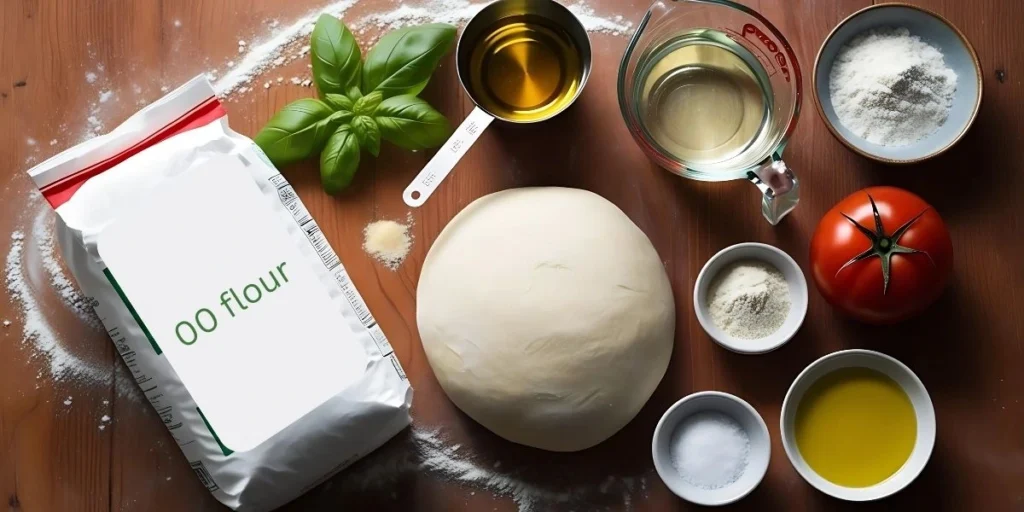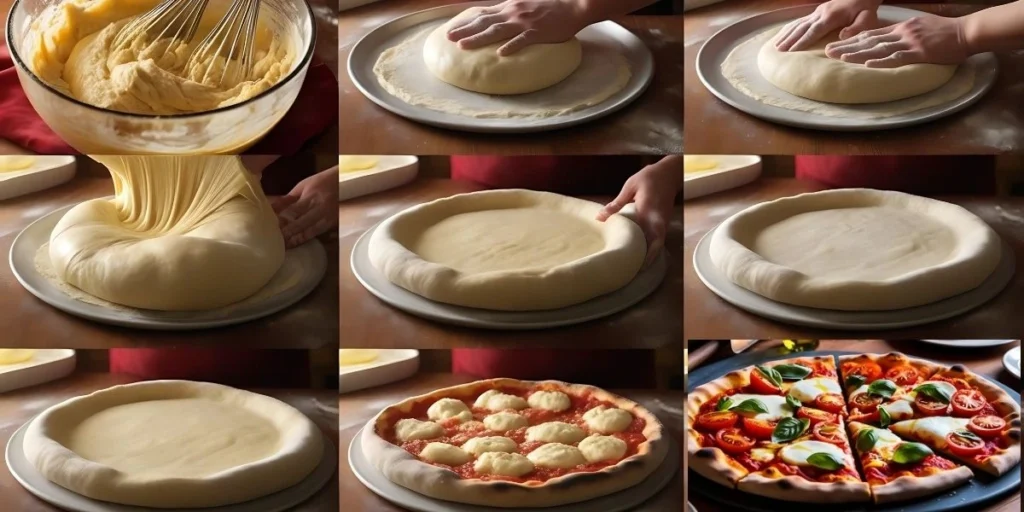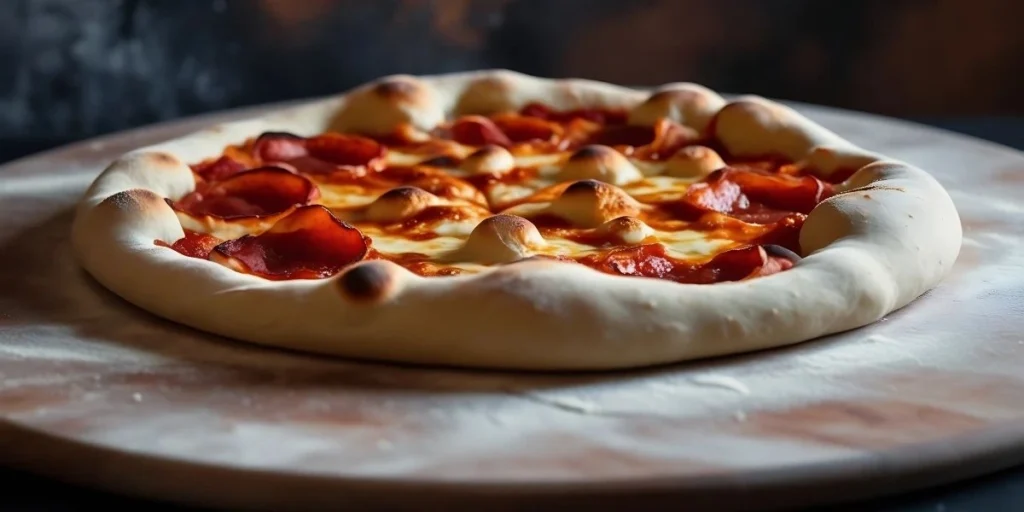Making pizza at home can feel like a magical experience, especially when you master the art of creating authentic Italian pizza dough Recipes.
The foundation of any great pizza, the dough transforms simple ingredients into a beloved dish. With a rich history rooted in Neapolitan traditions, Italian pizza dough is known for its airy texture, crispy crust, and unmistakable flavor, bringing Italy’s essence to your kitchen.
In this blog post, we’ll guide you step-by-step on how to make the best Italian pizza dough recipe at home. From selecting the right ingredients to perfecting kneading and proofing techniques, you’ll learn everything you need to create a dough that rivals your favorite pizzeria.
Whether you’re a beginner or an experienced home chef, these tips will help you achieve the perfect pizza crust every time. Let’s get started on this delicious journey to pizza perfection!
Ingredient Breakdown of Italian Pizza Dough Recipe
Quality ingredients are crucial for the best results. This breakdown will ensure your dough turns out restaurant-quality every time, no matter where you’re cooking—whether in the UK, Australia, or even New Zealand.

1. 00 Flour (500g)
This finely ground Italian flour sets the benchmark for exceptional pizza dough. Its light, elastic texture perfectly achieves the classic thin and chewy crust. In Italy, 00 flour is prized for its powdery consistency, which is ideal for high-heat baking in a traditional wood-fired oven. The protein content in 00 flour is moderate, providing enough gluten for stretch and structure without making the dough overly tough.
- Flavor and Texture Notes: Expect an airy yet chewy crust. The finely milled texture ensures that the dough is smooth and easy to work with.
- Substitution Options: If you’re in the UK or Australia and can’t find 00 flour, strong bread or all-purpose flour can work, although the texture won’t be as refined. For those following a gluten-free lifestyle, opt for a high-quality gluten-free flour blend that contains xanthan gum or psyllium husk to mimic the elasticity of gluten. This will give you a gluten-free Italian pizza dough recipe that’s delicious and not crumbly.
2. Instant Yeast (7g)
Instant yeast is a must for convenience and quick activation. Unlike active dry yeast, which needs to be dissolved and activated in warm water, instant yeast can be mixed directly into the dry ingredients. This yeast gives the dough a reliable rise, perfect for both same-day baking and overnight fermentations.
- Tips for Best Results: Make sure your yeast is fresh. If you aim for a deeper, more complex flavor, consider an overnight Italian pizza dough recipe that ferments slowly in the refrigerator.
- Alternatives: For those seeking an authentic Italian pizza dough recipe without yeast, use baking powder instead, but note that the flavor profile will change. For a more traditional, rustic flavor, try using a sourdough starter.
3. Water (325ml)
Water is more than just a binding agent—it plays a significant role in the dough’s hydration level, affecting the crust’s texture. Use lukewarm water to activate yeast and achieve a smooth dough. If precision is your goal, measuring water in grams ensures consistency, especially when baking in regions like New Zealand, where humidity can impact dough.
- Hydration Tip: Higher hydration levels (like 65-70%) yield a softer, airier crust. Be mindful of humidity in your environment and adjust as needed.
- Variations: For those experimenting with sourdough, using filtered water is crucial to avoid chlorine, which can hinder fermentation.
4. Olive Oil (2 tablespoons)
High-quality extra virgin olive oil adds a subtle richness and enhances the dough’s flavor profile. It also helps with the dough’s extensibility, making it easier to stretch without tearing.
- Authentic Touch: Jamie Oliver’s Italian pizza dough recipe often emphasizes the importance of using robust, peppery olive oil for a flavor boost. You can reduce the amount slightly for a healthier alternative, but the dough may be less tender.
- Substitution Idea: If olive oil is unavailable, avocado oil can be a neutral-flavoured substitute, though it won’t provide the same traditional taste.
5. Salt (10g)
Salt is key to developing the dough’s flavor. Fine sea salt ensures even distribution throughout the dough. In Italy, sea salt is preferred for its clean, bright flavor.
- Why It Matters: Salt strengthens the gluten structure, giving the dough a better rise and improving elasticity. Without it, the dough would taste flat and be harder to work with.
- Adjustments for Dietary Needs: If you’re making an Italian pizza dough recipe in grams for strict dietary tracking, measure salt precisely to ensure consistency in flavor and nutritional information.
Step-by-Step Instructions
Mastering the perfect Italian pizza dough is all about following the steps precisely. Every stage, from activating the yeast to shaping the dough, influences the final result.

1. Activate the Yeast
To start, in a medium-sized bowl, combine 7g of instant yeast with 325 ml of warm water (ideally between 37°C and 43°C or 98°F and 110°F). Stir gently until the yeast is fully dissolved, and let it sit for a few minutes until it becomes frothy. This indicates the yeast is active and ready to work magic on your dough.
- Tip for Overnight Fermentation: If you plan to make an overnight Italian pizza dough recipe, use cold water instead of warm. The cold temperature slows the fermentation, allowing a deeper, more complex flavor to develop as the dough rests in the fridge.
2. Mix the Dough
Add 500g of 00 flour and 10g of fine sea salt in a large mixing bowl. Stir to combine evenly. Create a well in the center of the flour mixture, and pour in the yeast-water mixture along with 2 tablespoons of high-quality olive oil.
Mix with a wooden spoon or your hands until a shaggy, slightly sticky dough begins to form. Make sure all the flour is incorporated, scraping down the sides of the bowl if needed.
- Pro Tip: If you’re in a humid environment, like New Zealand or the UK, you may need to adjust the flour or water slightly to get the perfect consistency. The dough needs to be moist while avoiding excessive stickiness.
3. Knead the Dough
Transfer the dough to a lightly floured surface. Knead energetically for 10-15 minutes until smooth and elastic. The kneading process develops gluten, giving the dough structure and chewiness. The texture should be stretchy and silky for a Neapolitan-style pizza dough but not too sticky.
- How to Test: Perform the “windowpane test” by stretching a small piece of dough between your fingers. It’s ready if it can stretch thinly without ripping.
- Variation for Gluten-Free Dough: If you’re making a gluten-free Italian pizza dough recipe, knead gently and for a shorter time. Gluten-free flours require less handling, and over-kneading can make the dough dense.
4. First Rise
Shape the kneaded dough into a smooth ball and place it in a lightly oiled bowl. Cover the bowl with a damp cloth or plastic wrap to prevent the dough from drying out. Allow it to rise for 1-2 hours in a warm place until it doubles in size. If your kitchen is cold, consider placing the bowl in the oven with just the light on.
- Overnight Option: Let the dough rest overnight in the fridge for an Italian pizza dough recipe that develops richer flavors. This slow fermentation adds a subtle tang and improved texture to the crust.
5. Shape the Dough
Gently punch down the dough after it has risen to release any excess air. Transfer it to a floured surface and divide it into equal-sized balls, depending on how many pizzas you want to make. Each dough ball should weigh approximately 250g, ideal for a standard 10-12 inch pizza.
Cover the balls with a damp cloth and let them rest for 15-30 minutes. This resting phase relaxes the gluten, making it simpler to shape the dough.
- Shaping Tip: Roll the dough out with a rolling pin or stretch it by hand, using gentle pulling motions for a thin crust. If you prefer a thicker, more traditional crust, shape the dough but don’t roll it out as thinly.
6. Top and Bake
Preheat your oven to its highest setting (250°C or 482°F), ideally using a pizza stone or a baking steel. Preheating for at least 30 minutes ensures a consistent, high temperature that creates the perfect crust.
- Topping: Add your favorite toppings, starting with a thin layer of tomato sauce, fresh mozzarella, and a drizzle of olive oil. Simplicity is key for authentic Italian flavors.
- Baking Time: Slide the pizza onto the stone or steel and bake for 8-10 minutes or until the crust is golden and bubbly. Keep an eye on the pizza, as high heat can cause it to cook quickly.
- Pro Tip for Crispiness: Consider par-baking the dough for 2 minutes before adding your toppings for an extra crispy base.
Enjoy your homemade pizza straight from the oven, savouring the authentic taste of Italy right at home.
Chef’s Tips and Tricks for Italian Pizza Dough Recipe
Mastering Italian pizza dough can be a rewarding experience with just a few expert tricks. From troubleshooting dough issues to presentation and equipment tips, these insights will help you achieve a professional-grade pizza every time.

1. Troubleshooting Dough Issues
Even seasoned pizza makers encounter challenges with dough consistency. Here’s how to troubleshoot common problems:
- Sticky Dough Fix: If your dough is too sticky and difficult to work with, sprinkle a little more 00 flour onto your work surface and knead lightly. Take care not to use too much flour, resulting in a tough dough. Instead, add flour sparingly, a tablespoon at a time, until the dough reaches a smooth, elastic texture.
- Dry or Crumbly Dough: If your dough feels too dry or is cracking, gradually add small amounts of water. Work the water into the dough until it becomes more cohesive and pliable.
- No-Yeast Option: If you’re trying to make an Italian pizza dough recipe without yeast, use 1 teaspoon of baking powder for every 500g of flour. While the flavor won’t be as rich as yeast-fermented dough, this method provides a quick, reliable rise for a soft crust.
- Overnight Fermentation: Refrigerate the dough overnight for an authentic Italian pizza dough recipe. This slow fermentation process enhances flavor and gives the dough a pleasant tang, much like a sourdough base.
2. Plating and Presentation Ideas
The beauty of a well-made pizza lies not only in its taste but also in its presentation. A few finishing touches can make your homemade pizza look and feel restaurant-quality:
- Finishing Touches: Once your pizza comes out of the oven, drizzle it with high-quality extra virgin olive oil. This adds a glossy sheen and a subtle peppery flavor. Garnish with fresh basil leaves for a burst of color and fragrance. For a modern twist, try topping your pizza with fresh arugula or a sprinkle of chili flakes for added heat.
- Serving Suggestions: Pair your pizza with a simple arugula salad tossed in lemon juice, olive oil, and shaved Parmesan. The salad’s peppery and tangy notes perfectly balance the pizza’s richness. For an Italian-style feast, serve alongside antipasti like marinated olives and bruschetta.
3. Essential Equipment for Perfect Pizza
Achieving a crispy, beautifully cooked crust is all about the right equipment. Here’s what to consider investing in:
- Pizza Stone or Steel: Using a pizza stone or baking steel is highly recommended. These tools retain and evenly distribute heat, mimicking the environment of a traditional wood-fired oven. Heat your stone or steel in the oven for at least 30 minutes before you start baking. This ensures your dough cooks evenly, with a crisp bottom and a soft, airy interior.
- Dough Scraper: A dough scraper is incredibly helpful for managing sticky dough, keeping your workspace tidy, and dividing the dough into equal portions.
- Pizza Peel: Use a pizza peel to transfer your pizza from the countertop to the oven easily. Dust it lightly with flour or cornmeal to prevent the dough from sticking.
4. Additional Tips for a Perfect Crust
- Pre-Baking: For those who like a super-crispy crust, try par-baking your dough for 1-2 minutes before adding the toppings. This method prevents a soggy base, especially when using wet ingredients like fresh tomatoes or mozzarella.
- Crust Variations: If you prefer an Italian thin-crust pizza dough recipe, roll out the dough very thinly and bake at the highest possible temperature. For a fluffier, bread-like crust, leave the dough thicker and bake slightly longer at a slightly lower temperature.
These chef’s tricks ensure that your pizza turns out perfect every time, with a delicious balance of flavour, texture, and presentation.
Nutritional Information and Dietary Insights
This Italian pizza dough recipe is simple yet incredibly versatile, making it a great base for various dietary preferences. Here’s what you need to know about its nutritional profile and how to adapt it to fit specific needs.

Nutritional Profile
The dough, made from 00 flour, olive oil, yeast, salt, and water, is naturally vegan, making it suitable for plant-based diets. Here’s a closer look at the nutritional aspects per typical serving (approximately 100g of dough):
| Nutrient | Amount per Serving |
|---|---|
| Calories | 250 |
| Total Fat | 6g |
| Saturated Fat | 1g |
| Carbohydrates | 47g |
| Dietary Fiber | 2g |
| Sugars | 0g |
| Protein | 8g |
| Sodium | 400mg |
- Calories and Macronutrients: A typical serving of this pizza dough is relatively low in fat, thanks to the small amount of olive oil used, and primarily provides carbohydrates from the 00 flour. This makes it a good energy source, perfect for a hearty meal.
- Olive oil has health benefits. It contains healthy monounsaturated fats, which benefit heart health and inflammation control.
- 00 Flour’s Role: Using 00 flour ensures the dough has a light, chewy texture, essential for an authentic Italian crust. It is more refined than whole wheat flour, but the occasional indulgence in a traditional pizza is a delicious treat.
Dietary Adaptations
Pizza dough is highly adaptable, and this recipe can be modified to meet various dietary restrictions or preferences. Here are some key adaptations:
- Gluten-Free Option: Use a high-quality gluten-free flour blend for a gluten-free Italian pizza dough recipe. Ensure the blend contains xanthan gum or psyllium husk, which act as binding agents and mimic the elasticity of gluten, allowing the dough to hold together and maintain a pleasant texture. This adaptation enables those with celiac disease or gluten intolerance to enjoy pizza without compromising taste or structure.
- Potato Pizza Dough: The Italian potato pizza dough recipe is another interesting adaptation. You get a softer and slightly denser crust by incorporating cooked and mashed potatoes into the dough. This version is great for those looking to add a unique twist or reduce gluten content, as the potatoes replace some of the flour.
- Low-Yeast and Sourdough Variations: If you’re sensitive to yeast or prefer a richer flavor, consider making an Italian sourdough pizza dough recipe. Sourdough fermentation adds a tangy flavor and makes the dough easier to digest.
Allergen and Lifestyle Considerations
- Vegan-Friendly: The dough contains no animal products, so it is perfect for vegans. Just be mindful of any non-vegan toppings you might add.
- Keto and Low-Carb: This traditional recipe may not be suitable for those on a keto or low-carb diet, but experimenting with low-carb flour like almond or coconut flour could create a more suitable alternative.
These insights highlight the flexibility of this Italian pizza dough recipe, making it suitable for a wide range of dietary lifestyles while still delivering flavour and texture. Enjoy the process of making pizza tailored to your needs, ensuring a delicious meal that everyone can enjoy!
Cultural or Regional Variations
Italian pizza is celebrated worldwide for its delicious toppings and the distinctive regional variations that define its dough and preparation methods. Each region of Italy has its own take on pizza, reflecting local ingredients, traditions, and culinary preferences. Here are some notable variations to explore:
1. Neapolitan Pizza Dough
The most renowned of all pizza styles, Neapolitan pizza hails from Naples and is characterized by its simplicity and focus on quality ingredients. The traditional Italian Neapolitan pizza dough recipe calls for just four essential components: 00 flour, water, yeast, and salt.
- Key Features: The dough is hand-kneaded and allowed to rise for longer, resulting in a soft, airy crust that puffs up beautifully in the oven. Authentic Neapolitan pizzas are typically cooked in wood-fired ovens at very high temperatures, creating a delicate char on the edges and a slightly chewy texture in the center. The use of San Marzano tomatoes and fresh mozzarella di bufala as toppings complement the dough’s mild flavor.
2. Potato Pizza Dough
In some regions of Italy, particularly in the north, potatoes are incorporated into pizza dough for a unique twist. The Italian potato pizza dough recipe adds cooked and mashed potatoes to the mixture, resulting in a softer, richer crust.
- Why Try This Variation: Adding potatoes enhances the dough’s texture and provides a subtle sweetness. This adaptation is particularly popular in rustic, traditional pizzerias and can be an excellent choice for those looking for a heartier pizza base. It pairs well with various toppings, from classic tomato and mozzarella to innovative combinations like gorgonzola and caramelized onions.
3. Sourdough Variation
Sourdough pizza is gaining popularity for its unique flavor profile and health benefits. By using a sourdough starter instead of commercial yeast, this variation introduces a tangy complexity to the dough.
- Benefits of Sourdough: The fermentation process enhances the flavor and improves digestibility and nutrient absorption. Sourdough pizza dough requires a longer rise time, often involving an overnight ferment, which helps develop its distinctive taste and texture. The crust becomes crispier, and the interior retains a chewy softness, making it a favorite among sourdough enthusiasts.
4. Regional Flavor Profiles
Each region in Italy adds its own flair to pizza. For example, Sicilian pizza is known for its thick, rectangular shape and robust toppings, while Roman pizza features a thin, crispy crust that’s perfect for snacking.
- Exploring Local Ingredients: When trying regional variations, consider local ingredients and traditional toppings that can enhance the experience. For instance, local cheeses, cured meats, or seasonal vegetables can bring a taste of Italy’s diverse culinary landscape to your homemade pizza.
These regional variations celebrate the rich cultural heritage of Italian pizza, encouraging experimentation and personalization in your pizza-making journey. Whether you prefer the classic Neapolitan style or are intrigued by the softness of potato dough, exploring these variations allows you to enjoy a piece of Italy right in your kitchen.

Craving something extraordinary to elevate your next meal? Discover our indulgent crab brulee recipe, a luxurious twist on the classic French dessert. It blends the creamy richness of brulee with the delicate flavors of fresh crab. This unforgettable dish will impress your guests and leave your taste buds tingling. Visit the recipe now and prepare to wow everyone with your culinary skills!
FAQs and Troubleshooting
As you embark on your pizza-making journey, you might have questions about storing leftovers, yeast options, and troubleshooting dough issues. Here’s a helpful guide to address common concerns and enhance your experience with this Italian pizza dough recipe.
How to Store Leftovers
If you find yourself with leftover pizza, proper storage is key to maintaining its quality:
- Refrigeration: To keep leftover slices fresh, wrap them in plastic wrap or aluminum foil. Store the wrapped pizza in the refrigerator for up to 3 days. This will help prevent the crust from becoming soggy while keeping the toppings flavorful.
- Reheating: To restore the pizza’s crispness, reheat it in a hot oven (around 200°C or 400°F) for about 10 minutes. Alternatively, you can cover the pizza on a hot skillet for a few minutes to ensure the cheese melts perfectly. This technique will provide you with a texture reminiscent of freshly baked goods.
Shelf Life of Pizza Dough
If you’ve made extra dough and want to save it for later, here’s how to store it effectively:
- Freezing: The dough can be frozen for up to 3 months. To do this, wrap the dough tightly in plastic wrap, then place it in an airtight container or a resealable freezer bag. Mark it with the date to monitor its freshness effectively. When you’re ready to use it, thaw it in the refrigerator overnight before using it.
Best Yeast Options
When it comes to yeast, the choice can affect the flavor and texture of your pizza dough:
- Instant Yeast: For convenience and quicker rise times, use instant yeast. It can be mixed directly into the dry ingredients, requiring no activation in warm water beforehand. This makes the dough preparation process faster and easier, perfect for those who are short on time.
- Active Dry Yeast: Opt for active dry yeast if you prefer a slower rise. This type requires activation before mixing with other ingredients, which can enhance the dough’s flavor through longer fermentation. Simply dissolve the active dry yeast in warm water (about 110°F or 43°C) with some sugar and let it sit until foamy before adding it to your flour mixture.
Common Troubleshooting Tips
- Dough Too Sticky: If your dough feels too sticky during kneading, sprinkle a little extra 00 flour onto your work surface and knead gently until it reaches a manageable consistency.
- Dough Not Rising: Ensure your yeast is fresh and your water is not too hot, as excessive heat can kill the yeast. If you’re in a colder environment, consider placing the dough in a warm spot, such as an oven with the light on, to encourage rising.
By following these tips and tricks, you can enjoy a hassle-free pizza-making experience and savour every delicious bite of your homemade Italian pizza. If you have additional questions or require more help, don’t hesitate to reach out!
Conclusion
This authentic Italian pizza dough recipe is not just a foundation for your favorite toppings; it’s a journey into the heart of Italian culinary tradition. Whether you choose to create a classic Neapolitan pizza with its airy crust, experiment with a rich potato dough for a unique twist, or indulge in the tangy complexity of sourdough, each variation offers a delightful experience for your taste buds.
Remember, the key to great pizza lies in using quality ingredients and allowing your dough the time it needs to develop flavor and texture. Don’t hesitate to get creative with your toppings and make this recipe your own!
We’d love to see how you personalize your pizza! Share your own versions on social media and tag us in your creations, or leave a comment with your thoughts.
Follow our blog for more delicious recipes and tips. Explore our other articles for inspiring dishes, from savory pasta to delightful desserts. Happy pizza making!

